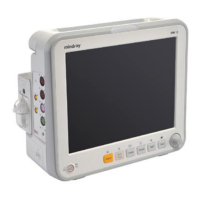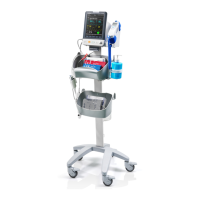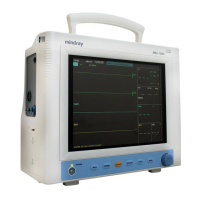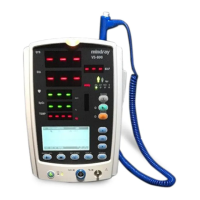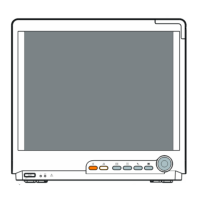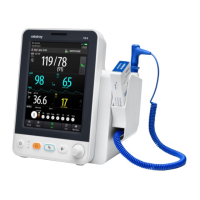Do you have a question about the Mindray iPM-9800 and is the answer not in the manual?
Details on assembling, testing, and troubleshooting equipment for effective repair.
For biomedical engineers, technicians, and service representatives for monitor maintenance.
Lists abbreviations used in the manual, such as CMS and PCB.
Information on DANGER, WARNING, CAUTION, and NOTE symbols used in the manual.
Explanation of hazard symbols and their meanings for user safety.
Explains various symbols used on the equipment and in the manual.
Overview of the patient monitor's intended use and functions for physiological parameter monitoring.
Details on mounting the patient monitor on a wall bracket or trolley support.
Describes various connectors on the back of the monitor like Network, Video, USB, etc.
Illustrates the structure of the patient monitor's main unit.
Overview of regular inspection, maintenance, and testing for proper monitor function.
Provides a table of recommended frequencies for various check/maintenance items.
Overview of module performance tests including CO2, ECG, NIBP, IBP, SpO2, etc.
Overview of electrical safety testing procedures to verify equipment safety.
Accessing factory maintenance and upgrading the monitor's software.
Overview of common problems and how to check monitor status.
A guide to diagnosing and resolving common monitor issues.
Troubleshooting for power, display, alarm, key, recorder, interface, CF card, and power supply failures.
Troubleshooting network-related problems and software upgrade failures.
Lists required tools and preparation steps before disassembling the monitor.
Procedure for separating the front and rear housing of the monitor.
Steps for disassembling the front housing, including component removal.
Steps for disassembling the rear housing, including component removal.
Detailed disassembly steps for various internal assemblies.
Introduction to the parts section and exploded view of the main unit.
Exploded views and parts lists for front, screen, and rear housing assemblies.
Exploded views and parts lists for main support, interface, and various module assemblies.
Lists of replaceable parts for the main unit and various cables used.
Details on assembling, testing, and troubleshooting equipment for effective repair.
For biomedical engineers, technicians, and service representatives for monitor maintenance.
Lists abbreviations used in the manual, such as CMS and PCB.
Information on DANGER, WARNING, CAUTION, and NOTE symbols used in the manual.
Explanation of hazard symbols and their meanings for user safety.
Explains various symbols used on the equipment and in the manual.
Overview of the patient monitor's intended use and functions for physiological parameter monitoring.
Details on mounting the patient monitor on a wall bracket or trolley support.
Describes various connectors on the back of the monitor like Network, Video, USB, etc.
Illustrates the structure of the patient monitor's main unit.
Overview of regular inspection, maintenance, and testing for proper monitor function.
Provides a table of recommended frequencies for various check/maintenance items.
Overview of module performance tests including CO2, ECG, NIBP, IBP, SpO2, etc.
Overview of electrical safety testing procedures to verify equipment safety.
Accessing factory maintenance and upgrading the monitor's software.
Overview of common problems and how to check monitor status.
A guide to diagnosing and resolving common monitor issues.
Troubleshooting for power, display, alarm, key, recorder, interface, CF card, and power supply failures.
Troubleshooting network-related problems and software upgrade failures.
Lists required tools and preparation steps before disassembling the monitor.
Procedure for separating the front and rear housing of the monitor.
Steps for disassembling the front housing, including component removal.
Steps for disassembling the rear housing, including component removal.
Detailed disassembly steps for various internal assemblies.
Introduction to the parts section and exploded view of the main unit.
Exploded views and parts lists for front, screen, and rear housing assemblies.
Exploded views and parts lists for main support, interface, and various module assemblies.
Lists of replaceable parts for the main unit and various cables used.
| SpO2 | Yes |
|---|---|
| NIBP | Yes |
| Temperature | Yes |
| Respiration | Yes |
| IBP | Yes |
| Arrhythmia Analysis | Yes |
| ST Analysis | Yes |
| OxyCRG | Yes |
| Drug Dose Calculation | Yes |
| Networking | Yes |
| Battery Life | Up to 4 hours |
| Power Supply | 100 - 240 VAC, 50/60 Hz |
| Display Type | TFT LCD |
| EtCO2 | Optional |
| AG | Optional |
| Cardiac Output | Yes |
| Connectivity | Ethernet, USB |
| Display Size | 12.1 inch |



